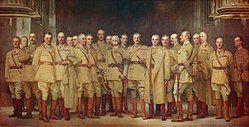Datei:1922 John Singer Sargent - General Officers of World War I - Detail.jpg
Zur Navigation springen
Zur Suche springen

Größe dieser Vorschau: 800 × 177 Pixel. Weitere Auflösungen: 320 × 71 Pixel | 640 × 141 Pixel | 2.400 × 530 Pixel
Originaldatei (2.400 × 530 Pixel, Dateigröße: 997 KB, MIME-Typ: image/jpeg)
Dateiversionen
Klicke auf einen Zeitpunkt, um diese Version zu laden.
| Version vom | Vorschaubild | Maße | Benutzer | Kommentar | |
|---|---|---|---|---|---|
| aktuell | 10:23, 24. Feb. 2018 | 2.400 × 530 (997 KB) | Waterborough | better version | |
| 09:13, 24. Feb. 2018 | 2.400 × 530 (991 KB) | Waterborough | == {{int:filedesc}} == {{Artwork |wikidata = Q16992699 |Title = ''General Officers of World War I'' |Artist = {{creator:John Singer Sargent}} |Year = 1922 |Technique = {{Technique|oil|canvas}} |Dimensions = {{size|cm|299.7|528.3}} |Gallery = National Portrait Gallery |Location = London |Notes = {{en|The painting depicts 22 of the approximately 1,500 brigadier-generals, major-generals, lieutenant-generals, generals, and field marshals who served in the British and Imperial armies in the First World War. All but two of the subjects reached the rank of at least lieutenant-general, and most were commanders of armies or army corps. The only two divisional commanders are Major-General Lukin and Major-General Russell. From left to right, they are: #Field Marshal William Birdwood, 1st Baron Birdwood (commander of the Australian and New Zealand Army Corps from 1914 to 1916, and of the British Fifth Army in 1918) #Field Mar... |
Dateiverwendung
Die folgende Seite verwendet diese Datei:
Globale Dateiverwendung
Die nachfolgenden anderen Wikis verwenden diese Datei:
- Verwendung auf ru.wikipedia.org



